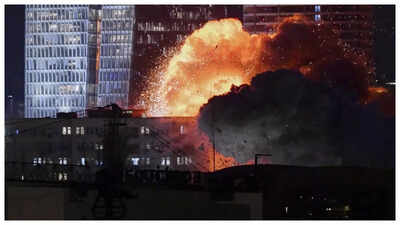ARTICLE AD BOX

Iran Israel conflict derails MBBS dreams of Indian students.
As air raid sirens blared and skies lit up with the hum of drones and fighter jets, hundreds of Indian medical students across Iranian universities faced a night of intense anxiety amid the latest flare-up between Iran and Israel.
On June 13, Israel initiated “Operation Rising Lion,” targeting Iranian military leadership and nuclear facilities, setting off the current wave of hostilities. The Israel Iran conflict 2025, which resulted in explosions and widespread blackouts, brought daily life to a standstill — forcing students, many of them pursuing MBBS degrees, into lockdown under emergency conditions.While the political tension had been building for weeks, the sudden escalation left students unprepared and vulnerable.
Iranian institutions hosting international students, including Tehran University of Medical Sciences, Iran University of Medical Sciences, Shiraz University, and others, became unlikely frontlines in a conflict far removed from the lecture halls and hospital rotations Indian students had come to pursue.
Consequently, many of the students, who had opted to study MBBS abroad due to the cost-effective and globally recognized nature of Iranian programmes, suddenly found themselves living through a conflict they were never prepared for.
Iran Israel conflict 2025: Indian MBBS students trapped between studies and strikes
The students, many of whom had chosen Tehran University for its affordable, globally recognized MBBS programme, found themselves abruptly thrust into a geopolitical crisis. While the conflict in the Middle East is not new, the direct involvement of Israel in this latest escalation raised alarm bells among international missions and families back in India.“After 2-3 hours, we heard the boom of fighter jets. We were really scared.
Our skies were filled with drones. From Friday evening to the next morning, we heard sounds continuously. There was a complete blackout, and we were sitting under the dormitory,” a student told ANI, recalling the chaotic hours that followed the initial strikes.The Indian Medical Council recognizes degrees from several Iranian medical institutions, making the country a cost-effective and increasingly popular destination for MBBS aspirants.
But the conflict has thrown their education plans into disarray. With exams postponed and classes disrupted, students say they are unsure when — or whether — they can return to normalcy.“Even if things calm down in a few weeks, the psychological impact will stay,” a final-year student from Mashhad University told ANI. “We came here to become doctors, not to learn to survive missile attacks,” he added.
Prompt institutional and diplomatic response
Fortunately, both the university authorities and the Indian government acted quickly.
Students recounted how senior staff at Tehran University were present within hours of the attack.“Our University (Tehran University of Medical Sciences) has been very helpful. As soon as the blasts happened, our Vice-Dean came to check upon us and calmed us. By the evening, our Dean also arrived and assured us that nothing would happen,” another student told ANI.On the diplomatic front, the Indian Embassy in Tehran created a dedicated Telegram communication channel exclusively for Indian students in Iran, as announced on its official X (formerly Twitter) account.
The link was widely circulated among student groups and Indian media. Embassy officials reportedly remained in close touch with university administration and the students themselves throughout the ordeal.
As the situation intensified, many Indian students were relocated to the city of Qom, approximately 148 km from Tehran, considered a safer zone for the time being.India's Ministry of External Affairs (MEA) assured that the government was closely watching developments in the region.
MEA spokesperson Randhir Jaiswal, in a statement posted on X, said “The Indian Embassy in Tehran is continuously monitoring the security situation and engaging Indian students in Iran to ensure their safety.”While there have been no reports of injuries or direct attacks on students, the psychological toll has been severe. For many, the fear lingers — not just about physical safety, but about their disrupted education, future uncertainty, and the looming question: should they stay, or should they return?
Between aspirations and anxiety: Are students prepared?
The Iran Israel conflict has brought a harsh spotlight on a frequently overlooked aspect of international education: crisis preparedness.
Indian students, particularly those headed to countries with complex political environments, often embark on their journeys without a full understanding of the risks — or a clear plan for what to do when danger strikes.The Tehran incident isn’t an isolated one. From Russia’s invasion of Ukraine to unrest in Sudan and now tensions in Iran, Indian students have repeatedly found themselves in conflict zones. Each time, the Indian government has managed to respond — from launching Operation Ganga in Ukraine to emergency advisories in Sudan — but questions remain about preparedness.The harrowing experience of Indian students in Tehran is a stark reminder that global education today carries global risks. While the Indian government and Tehran University deserve credit for their swift response, the larger ecosystem — parents, consultants, embassies, and universities — must come together to build a culture of proactive preparedness.
Career dreams may take students to the farthest corners of the world, but when conflict erupts, hope can vanish overnight. The question now is not just how we respond to emergencies — but how we ensure students are never this vulnerable again.



.png)
.png)
.png)
















 4 hours ago
4
4 hours ago
4









 English (US) ·
English (US) ·